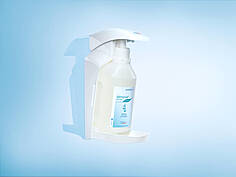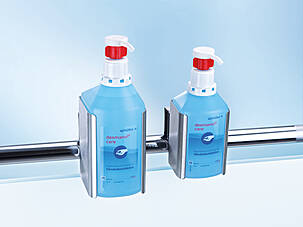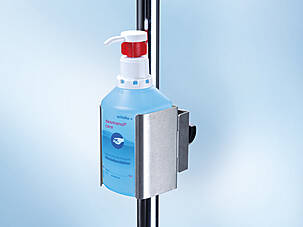World Hand Hygiene Day
Compliance at the point of care
On the occasion of International Hand Hygiene Day on the 5th of May 2024, schülke would like to draw attention to the importance of compliance in hand hygiene.
Optimal hand hygiene protects against invisible risks
The European Centre for Disease Prevention and Control (ECDC) estimates that approximately 8.9 million infections occur in European healthcare facilities annually.1
Hands represent, according to the latest scientific findings, the greatest risk of transmitting pathogens.2
Professional hand hygiene is therefore one of the most important preventive measures for protecting both staff and patients.
Properly performed hand hygiene reduces contamination with pathogens by up to 99.999%.
Hand hygiene in the healthcare facilities not only includes hand disinfection but also hand washing, skincare, and the use of gloves.
Hand disinfection plays a central role, because only disinfection is capable of rapidly reducing pathogens to such an extent that pathogens can’t be transmitted.
Nevertheless, continuous observations by the German National Reference Center in participating healthcare facilities indicate a decrease in hand disinfectant use following the COVID-19 pandemic (Figure 1).
For example, in 2021 and 2022, 11 % and 18 % less hand disinfectant was consumed in intensive care units compared to 2020. Similarly, in standard care units, hand disinfectant consumption in 2022 returned to pre-pandemic levels.3

The 5 moments of hand disinfection

The 5 moments of hand hygiene, as recommended by the WHO, specify when hygienic hand disinfection is crucial.
Following proper indication guidelines is the most important factor for hand hygiene compliance
In Germany, depending on the type of ward, relatively stable compliance rates between 76 % and 79 % were observed for 2022 compared to previous years. These are very good values, although still every 4th to 5th hand disinfection is omitted when indicated.3 Internationally, the situation is comparable. The WHO estimates compliance rates to rarely exceed 70 % in industrialized nations.4
Handwashing cleans, disinfecting ensures
Handwashing is intended to remove visible dirt and contamination with alcohol-resistant pathogens.8 Although soap removes dirt, it does not reliably or quickly inactivate pathogenic germs. Additionally, handwashing disperses pathogens but does not fully eradicate them (Figure 2).
The addition of antimicrobial agents in wash lotions is generally not required in medical facilities.2 When frequently used, alcohol-based hand disinfectant is also better tolerated by the skin than handwashing with wash lotion.8


Proper skin care increases the effectiveness of disinfection9

The healthier the skin, the smoother and less damaged its surface, the fewer germs will adhere. Therefore, the use of additional care products containing emollients and moisturizing factors is recommended.
Thus, hands should be cared for in the morning and evening and safeguarded in between and before activities that are harmful to the skin.
Wearing gloves is never a substitute for hygienic hand disinfection
The indiscriminate use of medical disposable gloves has been a matter of debate well before the COVID-19 pandemic. There’s an increasing tendency in institutions toward the “universal wearing” of medical disposable gloves10,11 even when not required12 – often to the detriment of hand hygiene compliance.
In an observational study, it was found that hygienic hand disinfection, despite being indicated before and after the use of gloves, was only carried out 19 % and 65 % of the time, respectively.11 Put simply, medical disposable gloves should always be changed according to the indications for hygienic hand disinfection.2,8 Additionally, they serve to directly protect the wearer from contamination, i.e., during procedures that may involve contact with potentially infectious material.

Compliance in hand hygiene means appropriately following the indications and the responsible implementation of each individual step
1 Suetens et al, 2018, Euro Surveill. 2 KRINKO, 2016, Händehygiene in Einrichtungen des Gesundheitswesens 3 HAND-KISS, https://www.nrz-hygiene.de/KISS-Modul/anleitungen/KISS/HAND 4 WHO, https://www.who.int/campaigns/world-handhygiene-day/2021/key-facts-and-figures 5 Kampf et al., 2013, Bellissimo-Rodriguez et al., 2016. 6 Goroncy-Bermes et al., 2010, Journal of Hospital Infection 7 Rotter et al., 2009, Hygiene Medizin;34(1/2):19–23. 8 Kramer et al., 2023, S2k-LL Händedesinfektion und Händehygiene 9 EURIDIKI. Ein Leitfaden zur hygienischen Händedesinfektion, Seite 50, mhp-Verlag 1996 10 Brunke et al., Epid Bull 2023;18:3-6 11 Imhof et al., 2021, GMS Hygiene and Infection Control 12 Fuller et al., 2011, Infection Control & Hospital Epidemiology 13 Pittet & Boyce, 2001, Lancet Infectious Diseases
schülke hand hygiene
Everything within reach at the point of care



At schülke, we support hand hygiene compliance not only through the broad efficacy and excellent skin compatibility of our hand disinfectants, but also throug their process-oriented placement, for example, with the hyclick® system in the direct patient environment. Read more about this at www.hyclick.com





































